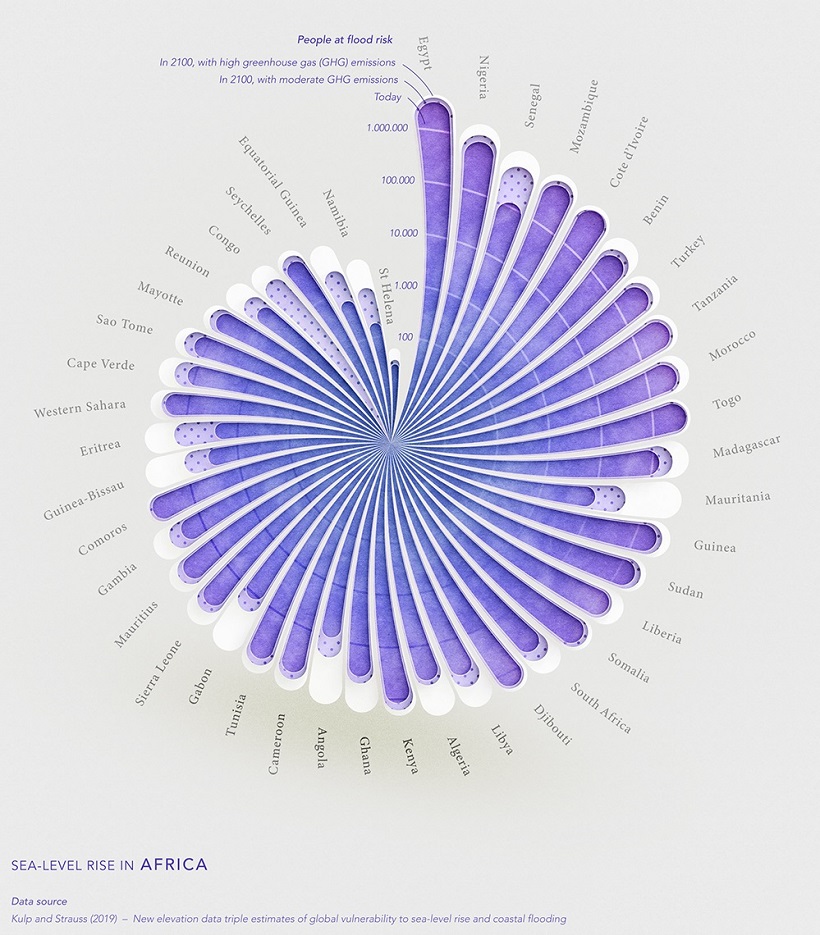녹색 해수면 상승의 영향을 국가별 시각화
녹색해수면 상승의 영향을 국가별 시각화
기후 변화는 이미 전 세계적으로 해수면을 상승시키고 있습니다. 20 세기에만 평균 세계 해수면이 11-16cm 상승한 것으로 추정됩니다.
앞으로 몇 년 동안 해수면은 얼마나 변할 것이며, 우리 인구에 어떤 영향을 미칠까요?
아래에서 일련의 시각화 플로렌트 라베르뉴 (Florent Lavergne)에 의해 우리는 해수면 상승이 2100 년까지 홍수 위험 측면에서 국가에 어떤 영향을 미칠 수 있는지 알 수 있습니다.
이러한 그래픽은 a의 데이터를 사용합니다. 2019 연구 스콧 쿨프와 벤자민 스트라우스. 그들의 연구는 극한의 해안 수위에 대한 인구의 잠재적 인 노출을 측정하는 데 사용되는 3D 그래픽 도구 인 CoastalDEM을 사용하고 다양한 수준의 온실 가스 (GHG) 배출량에서 해수면 상승을 조사했습니다.
지역별 홍수 위험
어느 나라가 해수면 상승으로 가장 심각한 영향을 받습니까?
상황이 그대로 계속된다면 전 세계 약 360 만 명의 사람들이 2100에 의해 매년 홍수 사건의 위험에 처할 수 있습니다. 각 지역에서 이러한 수치의 모양은 다음과 같습니다.
아프리카

On the continent of Africa, one of the countries with the highest number of people at risk of coastal flooding is Egypt.
Over 95% of Egypt’s population lives along the Nile river, with some areas situated at extremely low elevations. The country’s lowest point is 133 m below sea level.
Asia

Asia’s population will be more heavily impacted by flooding than any other region included in the dataset.
According to the projections, 70% of the people that will be affected by rising sea levels are located in just eight Asian countries: China, Bangladesh, India, Vietnam, Indonesia, Thailand, the Philippines, and Japan.
Europe

One of the most high-risk populations in Europe is the Netherlands. The country has a population of about 17 million, and as of 2019, about half of its population lives in areas below sea level.
The country’s lowest point, the town Nieuwekerk aan den Ijssel, is 6.8 m below sea level.
North America

In North America, the U.S., Canada, and Mexico are expected to see the highest numbers of impacted people, due to the size of their populations.
But as a percentage of population, other countries in Central America and the Caribbean are more greatly at risk, especially in high emission scenarios. One country worth highlighting is the Bahamas. Even based on moderate emission levels, the country is expected to see a significant surge in the number of people at risk of flood.
According to the World Bank, this is because land in the Bahamas is relatively flat, making the island especially vulnerable to sea level rises and flooding.
South America

As South America’s largest country by population and with large coastal cities, Brazil‘s population is the most at risk for flood caused by rising sea levels.
Notably, thanks to a lot of mountainous terrain and municipalities situated on high elevation, no country in South America faces a flood risk impacting more than 1 million people.
Oceania

By 2100, Polynesian countries like Tonga are projected to see massive increases in the number of people at risk of flooding, even at moderate GHG emissions.
According to Reuters, sea levels in Tonga have been rising by 6 mm each year, which is nearly double the average global rate. The reason for this is because the islands sit in warmer waters, where sea level changes are more noticeable than at the poles.
What’s Causing Sea Levels to Rise?
Since 1975, average temperatures around the world have risen 0.15 to 0.20°C each decade, according to research by NASA.
This global heating has caused polar ice caps to begin melting—in just over two decades, we’ve lost roughly 28 trillion tonnes of our world’s ice. Over that same timeframe, global sea levels have risen by an average of 36 mm. These rising sea levels pose a number of risks, including soil contamination, loss of habitat, and flooding.
As countries are affected by climate change in different ways, and at different levels, the question becomes how they will respond in turn.

이 기사는 Visual Capitalist의 일부로 출판되었습니다. 크리에이터 프로그램전 세계에서 가장 좋아하는 크리에이터의 데이터 기반 비주얼을 특징으로합니다.

2100에 의한 해수면 상승과 그 영향 시각화 (visualcapitalist.com)
Visualizing the Impact of Rising Sea Levels, by Country
Here's a look at how people around the world could be impacted by coastal flooding by 2100, based on rising sea level projections.
www.visualcapitalist.com
